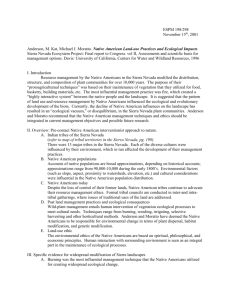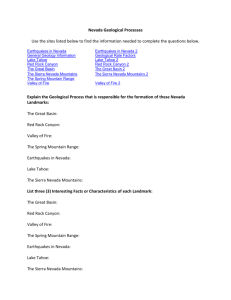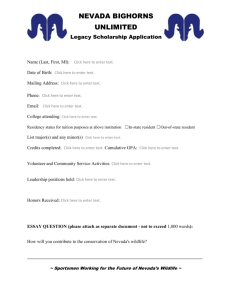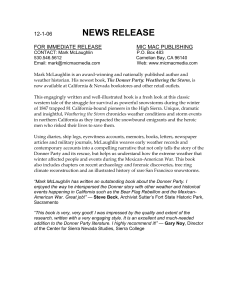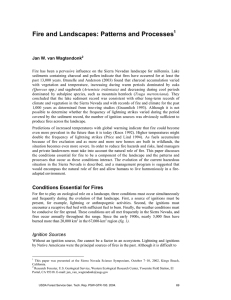Anderson, M - College of Natural Resources
advertisement
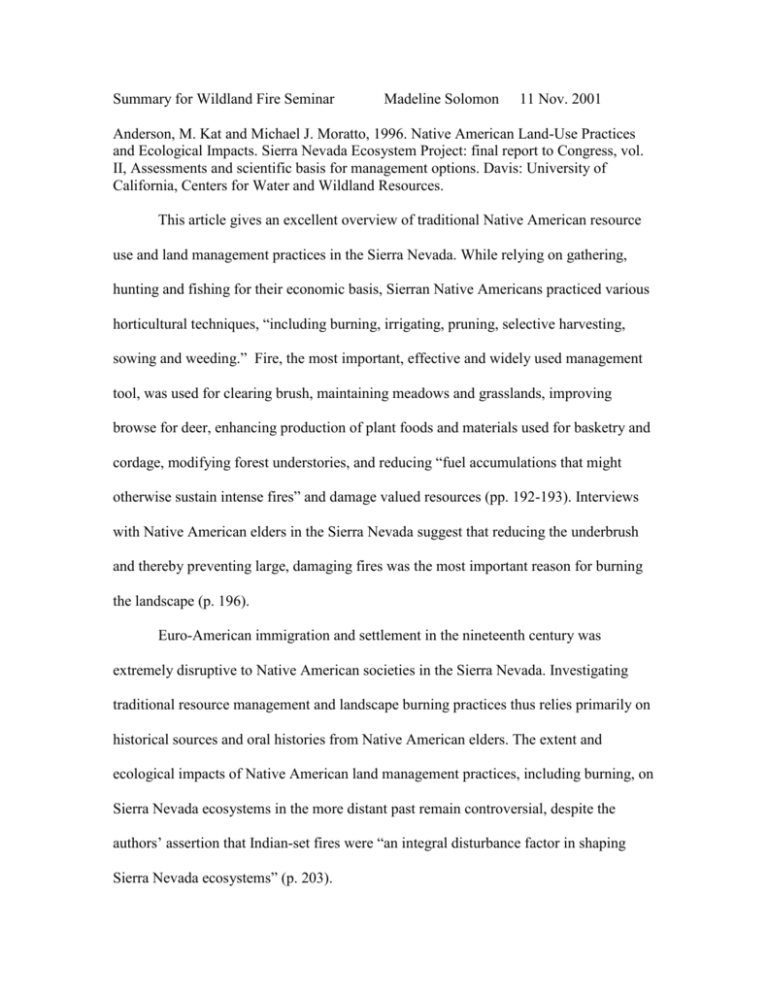
Summary for Wildland Fire Seminar Madeline Solomon 11 Nov. 2001 Anderson, M. Kat and Michael J. Moratto, 1996. Native American Land-Use Practices and Ecological Impacts. Sierra Nevada Ecosystem Project: final report to Congress, vol. II, Assessments and scientific basis for management options. Davis: University of California, Centers for Water and Wildland Resources. This article gives an excellent overview of traditional Native American resource use and land management practices in the Sierra Nevada. While relying on gathering, hunting and fishing for their economic basis, Sierran Native Americans practiced various horticultural techniques, “including burning, irrigating, pruning, selective harvesting, sowing and weeding.” Fire, the most important, effective and widely used management tool, was used for clearing brush, maintaining meadows and grasslands, improving browse for deer, enhancing production of plant foods and materials used for basketry and cordage, modifying forest understories, and reducing “fuel accumulations that might otherwise sustain intense fires” and damage valued resources (pp. 192-193). Interviews with Native American elders in the Sierra Nevada suggest that reducing the underbrush and thereby preventing large, damaging fires was the most important reason for burning the landscape (p. 196). Euro-American immigration and settlement in the nineteenth century was extremely disruptive to Native American societies in the Sierra Nevada. Investigating traditional resource management and landscape burning practices thus relies primarily on historical sources and oral histories from Native American elders. The extent and ecological impacts of Native American land management practices, including burning, on Sierra Nevada ecosystems in the more distant past remain controversial, despite the authors’ assertion that Indian-set fires were “an integral disturbance factor in shaping Sierra Nevada ecosystems” (p. 203). Historical and ethnographic data indicate that at the time of historic contact (in the early 1800s) there were about thirteen tribes speaking distinct languages in the Sierra Nevada with a combined population of perhaps 90,000-100,000 people. Population densities varied throughout the region. Occupations were highest in areas at 1,000-1,250 m (3,300-4,000 ft.) elevation and on the western rather than eastern side of the Sierra. Archaeological evidence suggests that the periods 7500-6000 B.C., 1000 B.C.-A.D. 700, and A.D. 1300-1800 were times of especially intensive occupation in the Sierra Nevada. Unfortunately, little is known about Native American land management practices in the Sierra Nevada during these earlier periods. Firewood collection alone may have substantially decreased fuel loads in inhabited areas during periods of more intensive occupation (pp. 195-196). The authors provide detailed case studies of the uses of fire in managing materials for producing basketry, food, and cordage. Sierran Native American basket weavers particularly valued the young adventitious and epicormic shoots from native shrubs including redbud, sourberry, hazelnut and various willow species for their length, flexibility, straightness, uniformity, absence of lateral branches, and color. The weavers needed large numbers of these young shoots for manufacturing the baskets that formed an integral part of their material culture. Such shoots occur relatively infrequently on wild shrubs; burning the shrubs increases the numbers of suitable shoots dramatically (Tables 9.1, 9.2, pp. 196-199). Traditionally, fires for basketry material were set at the bottoms of slopes in the fall, after one or two rains, at intervals of one to several years. Contemporary California Indian basket weavers similarly value young growth for basketry materials, and often substitute the pruning of individual shrubs to produce small quantities of desired materials in areas where land management policies prohibit landscape burning. Many different plants were managed with fire for optimal food production. Burning berry bushes increased fruiting and eliminated older wood, thus thinning dense shrubs and reducing insect damage. Sites from which greens and edible seeds were gathered were burned to promote young palatable growth, enhance seed production, recycle nutrients, keep areas open and free from invading shrubs and trees, and eliminate plant detritus and competition from weeds. Burning in areas from which bulbs, corms and tubers were collected not helped recycle nutrients, reduce competition from grasses and shrubs, and keep areas open, but also increased the size and quantity of the edible underground plant parts. Sierra Nevada Native Americans also burned mushroom patches to promote better yields and quality. Periodic burning of plants used for cordage promoted straighter and longer growth of usable materials and facilitated access for harvesting. Anderson and Moratto provide an insightful synthesis into the ecological dynamics of Native American land management practices in the Sierra Nevada. They emphasize that the Sierra Nevada was not an uninhabited wilderness at the time of first European contact, and that Native Americans had consistently intervened in some habitats for long periods, primarily through the use of intentional landscape fire, to promote heterogeneity in a changing landscape. As this synthesis has relevance for contemporary wildland management planning, as well as studying Native American practices in the Sierra Nevada, it seems appropriate to quote the passage in full here (pp. 188-189): The underlying management philosophy of Native Americans in the Sierra Nevada was to continuously introduce small disturbance regimes into various plant-community types, which created openings or clearings. These openings invited the colonization of plant species that could not grow in the surrounding dominant vegetation type. These clearings represented a series of earlier successional stages within a more homogeneous landscape. Rather than reflecting an unchanging system, these landscapes were much more dynamic under the influence of human disturbance than in their “natural” state. The nature and intensity of human intervention varied both geographically and diachronically. For example, some areas were subject only to lightning fires; other areas experienced both lightning- and Indianset fires; and yet other areas were shaped largely by anthropogenic forces (i.e., frequent Indian-set fires). The creation of specialized habitats intensified plant-plant, plant-animal, animal-animal, human-animal, and human-plant relationships, creating a highly interactive system that ultimately changed vegetation patterns over time. Hence, the objective is not to re-create exactly a static picture of historic landscapes, but rather to investigate and understand the native cultural processes that drove biological diversity and shaped various ecosystem states, and to unravel the ecological principles embedded in ancient land-management practices.


